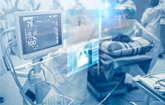
Medical Device Market Surges to USD 750 Billion by 2033, Propelled by 5.5% CAGR - Verified Market Reports®
The Medical Device Market is witnessing robust expansion driven by rising healthcare expenditure, growing prevalence of chronic diseases, and accelerating adoption of advanced diagnostic and therapeutic technologies. Continuous innovations in wearable devices, AI-integrated imaging systems, and minimally invasive surgical tools are transforming patient care and clinical efficiency. Strong demand for personalized medicine, telehealth integration, and digital health platforms is boosting product diversification and revenue generation.
LEWES, Del., Oct. 23, 2025 /PRNewswire/ -- The Global Medical Device Market is projected to grow at a CAGR of 5.5% from 2026 to 2033, according to a new report published by Verified Market Reports®. The report reveals that the market was valued at USD 500 Billion in 2024 and is expected to reach USD 750 Billion by the end of the forecast period.
Download PDF Brochure: https://www.verifiedmarketreports.com/download-sample/?rid=482507
Browse in-depth TOC on Medical Device Market
202 – Pages
126 – Tables
37 – Figures
Scope of The Medical Device Market Report
| REPORT ATTRIBUTES |
DETAILS |
| STUDY PERIOD |
2023-2033 |
| BASE YEAR |
2024 |
| FORECAST PERIOD |
2026-2033 |
| HISTORICAL PERIOD |
2023 |
| ESTIMATED PERIOD |
2025 |
| UNIT |
Value (USD Billion) |
| KEY COMPANIES PROFILED |
GE Healthcare, Siemens Healthcare, Philips Healthcare, Boston, Smith and Nephew, Medtronic |
| SEGMENTS COVERED |
By Surgical Devices, By Diagnostic Imaging Devices, By Monitoring Devices, By Therapeutic Devices, By Orthopedic Devices, By Geography |
| CUSTOMIZATION SCOPE |
Free report customization (equivalent to up to 4 analyst working days) with purchase. Addition or alteration to country, regional & segment scope |
Global Medical Device Market Overview
Medical Device Market: Trends and Opportunities
- Digital Health Integration: The rapid convergence of IoT-enabled devices, AI-driven diagnostics, and telemedicine platforms is redefining patient care, enabling real-time monitoring and personalized treatment strategies. Digital transformation is accelerating adoption across hospitals, clinics, and homecare environments.
- Regulatory Modernization and Quality Standards: Global harmonization of medical device regulations, such as post-market surveillance and MDR frameworks, is pushing manufacturers toward improved compliance, robust documentation, and advanced quality management systems.
- Shift Toward Minimally Invasive and Wearable Devices: Growing patient preference for non-invasive procedures is boosting the development of advanced surgical tools, implantable sensors, and remote monitoring wearables designed for high accuracy and efficiency.
- AI and Robotics Innovation: AI-powered diagnostics, surgical robotics, and predictive analytics are revolutionizing precision medicine, enhancing operational efficiency, and reducing clinical errors across diverse healthcare ecosystems.
- Expanding Applications in Chronic Disease Management: The rising prevalence of cardiovascular disorders, diabetes, and neurological conditions has amplified demand for smart implants, connected infusion systems, and portable imaging technologies supporting preventive and long-term care.
- Regional Growth Momentum: North America and Europe continue leading innovation pipelines, while Asia-Pacific demonstrates exponential growth through rising healthcare investments, manufacturing clusters, and supportive government initiatives driving localized production capabilities.
The global Medical Device Market is experiencing dynamic transformation driven by rapid technological innovation, growing healthcare expenditure, and the rising demand for precision-based, patient-centric care models. The convergence of digital health platforms, smart sensors, and data analytics is reshaping product development and clinical applications. Manufacturers are adopting predictive maintenance tools, AI-assisted imaging, and cloud-integrated diagnostic systems to improve operational efficiency and deliver scalable solutions for healthcare providers.
The market's growth trajectory is further strengthened by favorable reimbursement policies, expanding aging populations, and the growing awareness of early disease detection. Medical device firms are strategically shifting toward value-based care, leveraging advanced material science and sustainable manufacturing techniques to achieve regulatory compliance and minimize lifecycle costs. Despite its strong potential, the industry faces regulatory complexities, data interoperability challenges, and stringent safety validation procedures that could restrain short-term scalability.
What are the key drivers accelerating the growth of the Medical Device Market, and how are companies capitalizing on these opportunities?
The primary market drivers include technological convergence, escalating demand for connected healthcare, and the emergence of precision diagnostics. The proliferation of smart medical devices integrated with AI and IoT technologies is transforming how healthcare systems collect, process, and utilize patient data. The global push for preventive healthcare and early diagnosis has amplified the adoption of portable imaging systems, digital monitoring platforms, and telehealth-supported devices.
Companies are capitalizing on these drivers by adopting scalable R&D models, strategic partnerships, and acquisitions to enhance product portfolios. Large enterprises are focusing on interoperability and cybersecurity to ensure secure patient data flow, while startups are exploring niche innovations such as biosensors, wearable ECGs, and personalized drug delivery systems. This synergy between established players and emerging innovators is creating a robust ecosystem fostering faster clinical validation and broader market penetration. The integration of big data analytics in device performance tracking is further enabling predictive maintenance, optimizing workflow, and enhancing patient outcomes—critical factors influencing procurement decisions in hospitals and clinics.
To Purchase a Comprehensive Report Analysis: https://www.verifiedmarketreports.com/ask-for-discount/?rid=482507
What are the major restraints limiting the Medical Device Market expansion, and how are stakeholders addressing these barriers?
The most significant restraints affecting the market include stringent regulatory requirements, data privacy concerns, and high product development costs. The complexity of obtaining product approval from multiple regulatory bodies slows time-to-market, while continuous updates in standards like the EU MDR and FDA guidelines increase compliance expenses. Moreover, the growing use of connected devices raises cybersecurity vulnerabilities, making secure integration across healthcare networks a top priority.
Stakeholders are addressing these restraints through adaptive compliance frameworks, investment in advanced cybersecurity architectures, and collaborative engagement with regulators for transparent approval pathways. The adoption of digital twin technologies and simulation-based validation models helps manufacturers reduce clinical trial durations and improve product reliability before launch. Industry players are also leveraging cloud-based quality management systems (QMS) to streamline documentation, automate risk analysis, and ensure adherence to international safety standards. As digital ecosystems mature, the market is witnessing a gradual shift toward unified regulatory platforms promoting innovation without compromising patient safety.
Technological Developments Shaping the Future of the Medical Device Market
The next generation of medical devices is defined by cross-domain innovation—merging biotechnology, materials engineering, and artificial intelligence. Smart implants capable of wireless communication are now used for continuous patient monitoring, transmitting real-time metrics to cloud-based dashboards. Advanced imaging modalities powered by deep learning algorithms are enhancing diagnostic accuracy while reducing manual interpretation times. 3D printing is revolutionizing device prototyping and personalized prosthetics manufacturing, improving design flexibility and lowering production costs.
Robotic-assisted surgery is another breakthrough area, offering enhanced dexterity, precision, and shorter recovery times. Nanotechnology is being adopted for targeted drug delivery systems and biosensing applications, opening new possibilities in oncology, neurology, and regenerative medicine. In parallel, sustainability has become a core innovation pillar, with manufacturers investing in recyclable polymers, low-energy manufacturing, and green sterilization techniques to align with ESG-driven procurement models.
Medical Device Market Application Landscape and Market Penetration Strategies
Medical devices have diverse applications across diagnostic imaging, cardiology, orthopedics, wound management, dental care, and home healthcare. The expanding prevalence of chronic conditions has intensified the adoption of monitoring and therapeutic devices, especially in outpatient and home settings. Firms are pursuing multi-channel penetration strategies that combine traditional hospital procurement with direct-to-consumer distribution, e-commerce integration, and subscription-based device leasing models.
Product differentiation through software-driven intelligence is reshaping market competition. Manufacturers are embedding AI algorithms for automated calibration, predictive alerts, and clinical decision support, enhancing both efficiency and reliability. Furthermore, the integration of interoperable systems facilitates seamless data exchange across EHRs (Electronic Health Records) and clinical databases, promoting holistic patient management and data-driven insights for healthcare professionals.
Medical Device Market Regulatory Shifts and Quality Management Dynamics
Regulatory transformation remains one of the most influential forces in the medical device landscape. The global move toward harmonized standards is compelling organizations to adopt proactive compliance systems supported by real-time analytics. The U.S. FDA, European Commission, and WHO are emphasizing post-market surveillance, risk-based audits, and transparency to ensure device efficacy and patient safety.
Manufacturers are increasingly relying on digital documentation, blockchain-backed traceability, and automated validation to maintain data integrity across supply chains. This shift toward digital compliance is accelerating approval timelines and improving stakeholder trust. Emerging markets are aligning their frameworks with global standards, enhancing export potential while driving localized manufacturing opportunities through policy incentives and public–private partnerships.
Medical Device Market: Geographic Dominance
North America maintains a dominant position in the global medical device market due to robust healthcare infrastructure, advanced R&D capabilities, and strong regulatory frameworks. The region benefits from consistent investments in precision medicine, AI-based diagnostics, and high-value surgical instruments. According to global healthcare economic assessments, North America accounts for a substantial share of medical device expenditure, driven by high adoption rates in diagnostic imaging, cardiovascular systems, and orthopedic devices.
Europe follows closely, with its innovation ecosystem strengthened by sustainable medical manufacturing and strong government reimbursement models. The region's emphasis on quality assurance and regulatory compliance under the European Medical Device Regulation (MDR) supports long-term market stability. Meanwhile, the Asia-Pacific region demonstrates the fastest growth trajectory, propelled by expanding healthcare infrastructure in countries such as China, India, Japan, and South Korea. WHO data indicates rising public healthcare investments and a growing focus on domestic device manufacturing under 'Make in India' and similar initiatives, enhancing regional self-sufficiency.
Latin America and the Middle East & Africa are emerging as attractive frontiers, supported by increasing hospital modernization programs and rising demand for cost-effective, portable diagnostic solutions. These regions are gradually aligning with international safety benchmarks, attracting foreign direct investments and fostering cross-border collaborations for product innovation and regulatory harmonization.
The Medical Device Market is on a strategic growth path powered by innovation, regulation, and collaboration. The integration of AI, robotics, and digital health technologies is unlocking new frontiers in patient care while reshaping the global healthcare delivery model. For investors and executives, the focus remains on building scalable innovation ecosystems, strengthening compliance infrastructure, and leveraging emerging regional opportunities. As healthcare systems evolve toward predictive and preventive care, the medical device industry stands poised for sustainable, technology-driven expansion.
Medical Device Market: Key Players Shaping the Future
Leading industry participants such as GE Healthcare, Siemens Healthcare, Philips Healthcare, Boston, Smith and Nephew, Medtronic, among others, are instrumental in driving the evolution of the market. These companies influence market dynamics through continuous innovation, strategic partnerships, and global expansion initiatives. Comprehensive analyses of their financial performance, product portfolios, and SWOT evaluations offer critical insights into their competitive positioning and the overall trajectory of the industry.
Medical Device Market: Segments Analysis
Based on the research, Verified Market Reports® has segmented the global Medical Device Market into Engine Surgical Devices, Diagnostic Imaging Devices, Monitoring Devices, Therapeutic Devices, Orthopedic Devices, Geography.
To get market data, market insights, and a comprehensive analysis of the Global Medical Device Market, please Contact Verified Market Reports®.
By Surgical Devices
- Instruments
- Electrosurgical Devices
- Sutures and Staples
By Diagnostic Imaging Devices
- X-ray Imaging Systems
- MRI Machines
- Ultrasound Devices
By Monitoring Devices
- Vital Signs Monitors
- Neuromonitoring Devices
- Respiratory Monitors
By Therapeutic Devices
- Infusion Pumps
- Dialysis Equipment
- Pain Management Devices
By Orthopedic Devices
- Implants
- Surgical Instruments
- Supportive Devices
Medical Device Market, By Geography
- North America
- U.S
- Canada
- Mexico
- Europe
- Germany
- United Kingdom
- France
- Italy
- Spain
- Netherlands
- Rest of Europe
- Asia Pacific
- China
- Japan
- India
- South Korea
- Australia
- Indonesia
- Rest of Asia Pacific
- Latin America
- Brazil
- Argentina
- Chile
- Colombia
- Middle East & Africa (MEA)
- United Arab Emirates (UAE)
- Saudi Arabia
- South Africa
- Egypt
- Israel
Browse Related Reports:
Global Aesthetic Medical Device Market Size By Technology (Laser-based, Light-based), By Application (Acne And Acne Scars, Hair Removal), By End User (Dermatology And Cosmetic Clinics, Hospitals And Clinics), By Type Of Device (Energy-based Aesthetic Devices, Non-energy-based Aesthetic Devices), By Product (Devices, Aesthetic Implants), By Geographic Scope And Forecast
Global Portable Medical Device Market Size By Product Type (Monitoring Devices, Diagnostic Devices), By End-User (Hospitals and Clinics, Home Care Settings), By Technology (Bluetooth-based Devices, Wi-Fi-enabled Devices), By Application (Cardiovascular Applications, Diabetes Management), By Mobility (Handheld Devices, Carts/Portable Systems), By Geographic Scope And Forecast
Global Disposable Medical Devices Market Size By Product Type (Disposable Syringes, Disposable Surgical Instruments), By Application (Diagnostic Applications, Therapeutic Applications), By End-User (Hospitals and Clinics, Ambulatory Surgical Centers), By Material Type (Plastic, Metal), By Sterility (Sterile Disposable Medical Devices, Non-Sterile Disposable Medical Devices), By Geographic Scope And Forecast
Global Gynecological Medical Devices Market Size By Product Type (Diagnostic Devices, Treatment Devices), By Application (Gynecological Surgery, Diagnostics), By End User (Hospitals, Clinics), By Technology (Traditional Technology, Advanced Technology), By Gender (Female, Male), By Geographic Scope And Forecast
Global Respiratory Care Medical Devices Market Size By Product (Therapeutic Devices, Diagnostic Devices), By Indication (Chronic Obstructive Pulmonary Disease, Sleep Apnea), By End User (Hospitals, Home Care Settings), By Device Type (Positive Airway Pressure Devices, Ventilators), By Monitoring Device Type (Pulse Oximeters, Spirometers), By Geographic Scope And Forecast
About Us
Verified Market Reports® stands at the forefront as a global leader in Research and Consulting, offering unparalleled analytical research solutions that empower organizations with the insights needed for critical business decisions. Celebrating 10+ years of service, Verified Market Reports has been instrumental in providing founders and companies with precise, up-to-date research data.
With a team of 500+ Analysts and subject matter experts, Verified Market Reports leverages internationally recognized research methodologies for data collection and analyses, covering over 15,000 high impact and niche markets. This robust team ensures data integrity and offers insights that are both informative and actionable, tailored to the strategic needs of businesses across various industries.
Verified Market Reports' domain expertise is recognized across 14 key industries, including Semiconductor & Electronics, Healthcare & Pharmaceuticals, Energy, Technology, Automobiles, Defense, Mining, Manufacturing, Retail, and Agriculture & Food. In-depth market analysis cover over 52 countries, with advanced data collection methods and sophisticated research techniques being utilized. This approach allows for actionable insights to be furnished by seasoned analysts, equipping clients with the essential knowledge necessary for critical revenue decisions across these varied and vital industries.
Verified Market Reports® is also a member of ESOMAR, an organization renowned for setting the benchmark in ethical and professional standards in market research. This affiliation highlights Verified Market Reports' dedication to conducting research with integrity and reliability, ensuring that the insights offered are not only valuable but also ethically sourced and respected worldwide.
Contact Us
Mr. Edwyne Fernandes
Verified Market Reports® US: +1 (650)-781-4080
US Toll Free: +1 (800)-782-1768
Email: [email protected]
Web: https://www.verifiedmarketreports.com/
Logo: https://mma.prnewswire.com/media/2486715/5468917/VM_Reports.jpg
SOURCE Verified Market Reports








Share this article